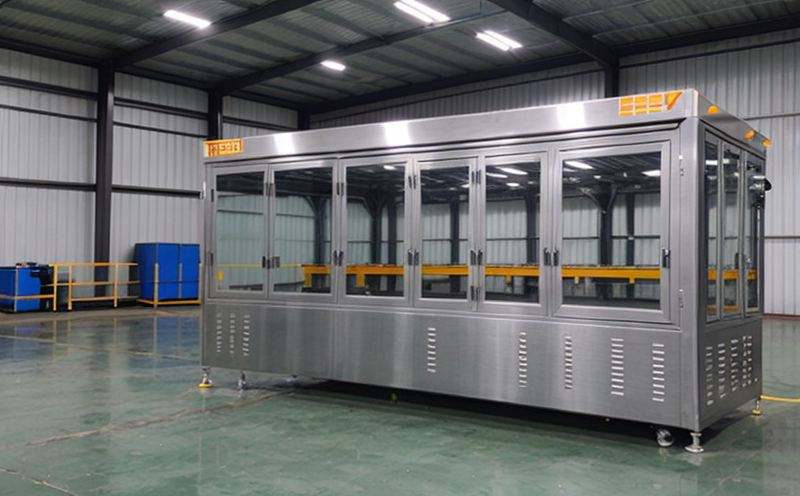ASTM F1345 Metal Can Seam Strength Testing
The ASTM F1345 test method is a critical standard used to evaluate the seam strength of metal cans. This test ensures that the seams holding the contents are robust enough to withstand various stresses and strains, thereby guaranteeing product integrity during storage, distribution, and use.
This testing procedure involves subjecting the can seam to tensile forces until failure occurs. The primary objective is to determine the maximum load at which a metal can seam fails in tension. Understanding this strength parameter helps manufacturers identify potential weaknesses in their packaging design and optimize the materials used for seamless integrity.
The ASTM F1345 test protocol specifies that the specimen should be prepared by cutting a 200 mm length of the seam from a representative sample of metal cans. The cut is made perpendicular to the seam line, ensuring uniformity across all specimens. Once cut, the edges are smoothed to prevent any irregularities that could affect measurement accuracy.
The testing apparatus typically consists of a tensile tester capable of applying controlled forces along the lengthwise direction of the seam. A fixture clamps one end of the specimen while the other end is attached to a load cell measuring up to 5 kN or more depending on sample size and expected strength. As the machine applies increasing tension, it records displacement and force data until failure.
The acceptance criteria for passing this test vary based on the type of metal used in construction (e.g., aluminum vs steel) as well as intended end-use applications like food storage versus beverage containers. Generally speaking, cans must demonstrate sufficient seam strength to ensure they do not leak under standard handling conditions such as stacking during transport or vibration during shipment.
In addition to basic tensile testing, some advanced laboratories may offer additional services including burst testing where the can is pressurized beyond its intended use case to assess long-term durability. This provides valuable insights into how well-designed seams perform over extended periods under real-world scenarios.
The importance of ASTM F1345 cannot be overstated given its role in ensuring consumer safety and satisfaction while maintaining brand reputation through high-quality packaging design.
- Ensures product integrity during distribution and use
- Identifies potential weaknesses in packaging design
- Optimizes material selection for seamless integrity
- Prevents leaks under standard handling conditions
- Assesses long-term durability through burst testing
By adhering to the strict requirements outlined by ASTM F1345, manufacturers can ensure their products meet industry standards and consumer expectations. This not only enhances brand reputation but also contributes significantly towards reducing waste associated with defective packaging.
Quality and Reliability Assurance
The ASTM F1345 seam strength testing is just one component of a comprehensive quality assurance program aimed at delivering reliable, high-quality products to consumers. By incorporating this test into their manufacturing processes, companies can ensure that every metal can produced meets strict safety and performance criteria.
Quality managers rely on such tests to verify that all components meet necessary specifications before being incorporated into larger assemblies or final products. This helps prevent costly recalls due to substandard materials or workmanship issues. Compliance officers also benefit from regular seam strength testing as it provides evidence of adherence to relevant regulations and industry best practices.
R&D engineers utilize these results to refine their designs, improve manufacturing methods, and develop new innovations that enhance overall product performance. Procurement teams can leverage this information when selecting suppliers or negotiating contracts with existing partners based on demonstrated capability in meeting stringent quality standards.
Overall, the ASTM F1345 seam strength testing serves as an essential tool for maintaining consistent quality across all stages of production, from raw material sourcing to finished goods delivery. It plays a vital role in safeguarding public health and safety while fostering innovation within the packaging sector.
Environmental and Sustainability Contributions
The ASTM F1345 seam strength testing contributes positively to environmental sustainability efforts by promoting efficient resource utilization throughout the product lifecycle. Strong seams contribute to longer-lasting packaging, reducing waste generation at both consumer end-of-life disposal points as well as during manufacturing processes.
- Reduces material usage through optimized design
- Promotes recycling by extending product lifespan
- Minimizes energy consumption associated with frequent replacement
- Supports circular economy principles through durable construction practices
Additionally, by ensuring reliable packaging performance, companies can reduce the amount of wasted goods resulting from premature failure. This translates into lower environmental impact and reduced carbon footprint across supply chains.
The ASTM F1345 seam strength testing aligns closely with global initiatives aimed at promoting sustainable development goals (SDGs), particularly SDG 12 which focuses on responsible consumption and production. Through rigorous quality assurance measures like this, industries contribute significantly towards achieving these objectives.
Competitive Advantage and Market Impact
The ASTM F1345 seam strength testing offers several competitive advantages that can enhance a company's market position. Firstly, it provides valuable insights into the performance characteristics of different metal types and manufacturing techniques used in can production.
By demonstrating superior seam strength compared to competitors' offerings, manufacturers can differentiate themselves in crowded markets where product quality is paramount. This translates directly into increased customer satisfaction and loyalty among end-users who value durable packaging solutions.
In terms of regulatory compliance, adherence to ASTM F1345 ensures that companies stay ahead of changing legal requirements without sacrificing innovation. As governments worldwide implement stricter environmental regulations, having a proven track record in maintaining high standards for seam strength becomes increasingly important.
From an operational standpoint, the ASTM F1345 testing process fosters continuous improvement initiatives within organizations. Regular assessments allow teams to identify areas of improvement and implement changes that lead to enhanced productivity and efficiency across various departments involved in can manufacturing.
The market impact extends beyond individual firms; it influences broader industry trends by setting benchmarks for acceptable seam strength levels. As more companies adopt similar testing protocols, the overall quality standards for metal packaging improve, benefiting consumers globally who ultimately enjoy safer, higher-quality products.





